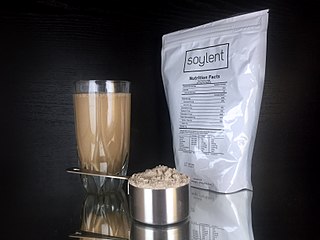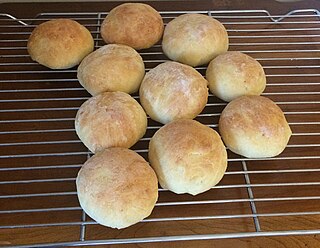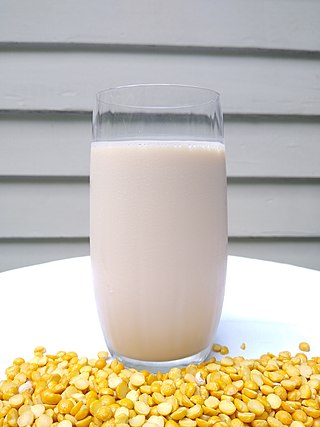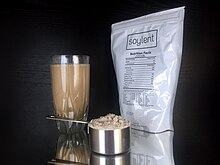
Nutella is a brand of brown, sweetened hazelnut cocoa spread. Nutella is manufactured by the Italian company Ferrero and was introduced in 1964, although its first iteration dates to 1963.

The soybean, soy bean, or soya bean is a species of legume native to East Asia, widely grown for its edible bean, which has numerous uses.

Gatorade is an American brand of sports-themed beverage and food products, built around its signature line of sports drinks. Gatorade is currently manufactured by PepsiCo and is distributed in over 80 countries. The beverage was first developed in 1965 by a team of researchers led by Dr. Robert Cade. It was originally made for the Gators at the University of Florida to replenish the carbohydrates that the school's student-athletes burned and the combination of water and electrolytes that they lost in sweat during vigorous sports activities.

A milkshake is a sweet beverage made by blending milk, ice cream, and flavorings or sweeteners such as butterscotch, caramel sauce, chocolate syrup, or fruit syrup into a thick, sweet, cold mixture. It may also be made using a base made from non-dairy products, including plant milks such as almond milk, coconut milk, or soy milk. Dry ingredients such as whole fruit, nuts, seeds, candy, or cookies may be incorporated.

Soy milk, also known as soya milk or soymilk, is a plant-based drink produced by soaking and grinding soybeans, boiling the mixture, and filtering out remaining particulates. It is a stable emulsion of oil, water, and protein. Its original form is an intermediate product of the manufacture of tofu. Originating in China, it became a common beverage in Europe and North America in the latter half of the 20th century, especially as production techniques were developed to give it a taste and consistency more closely resembling that of dairy milk. Soy milk may be used as a substitute for dairy milk by individuals who are vegan or lactose intolerant.

Energy bars are supplemental bars containing cereals, micronutrients, and flavor ingredients intended to supply quick food energy. Because most energy bars contain added protein, carbohydrates, dietary fiber, and other nutrients, they may be marketed as functional foods. Manufacturing of energy bars may supply nutrients in sufficient quantity to be used as meal replacements.

Special K is an American brand of breakfast cereal and meal bars originally manufactured by Kellogg's. The cereal was introduced to the United States in 1955. It is made primarily from grains such as lightly toasted rice, wheat and barley. Special K used to be marketed primarily as a low-fat cereal that can be eaten to help one lose weight. Following the 2023 spinoff of Kellogg's North American cereal division, the cereal is manufactured by WK Kellogg Co for the United States, Canada, and Caribbean markets. The former Kellogg's, renamed Kellanova, continues to manufacture the cereal for the rest of the world and the meal bars for all markets.

Kerry Group plc is a public food company headquartered in Ireland. It is quoted on the Dublin ISEQ and London stock exchanges.

Banchan are small side dishes served along with cooked rice in Korean cuisine. Banchan are set in the middle of the table to be shared. At the center of the table is the secondary main course, such as galbi or bulgogi, and a shared pot of jjigae. Bowls of cooked rice and guk (soup) are set individually. Banchan are served in small portions, meant to be finished at each meal and replenished during the meal if not enough. Usually, the more formal the meals are, the more banchan there will be. Jeolla province is particularly famous for serving many different varieties of banchan in a single meal.

Ensure is an American brand of nutritional supplements and meal replacements manufactured by Abbott Laboratories.

Soy protein is a protein that is isolated from soybean. It is made from soybean meal that has been dehulled and defatted. Dehulled and defatted soybeans are processed into three kinds of high protein commercial products: soy flour, concentrates, and isolates. Soy protein isolate has been used since 1959 in foods for its functional properties.

A smoothie is a beverage made by puréeing ingredients in a blender. A smoothie commonly has a liquid base, such as fruit juice or milk or yogurt. Other ingredients may be added, including fruits, vegetables, non-dairy milk, crushed ice, whey powder or nutritional supplements.

A meal replacement is a drink, bar, soup, etc. intended as a substitute for a solid food, usually with controlled quantities of calories and nutrients. Some drinks come in powdered form or pre-mixed health shakes that can be cheaper than solid foods with identical health qualities. Medically prescribed meal replacement drinks include the body's necessary vitamins and minerals. Bodybuilders sometimes use meal replacements, not formulated for weight loss, to save food preparation time when eating 5-6 meals a day.

Nesquik is a brand of food products made by Swiss company Nestlé. In 1948, Nestlé launched a drink mix for chocolate-flavored milk called Nestlé Quik in the United States; this was released in Europe during the 1950s as Nesquik.
Ambronite is a nutritional drinkable meal replacement intended to supply all of a human body's daily needs, made from 20 organic ingredients that includes berries, nuts, seeds and spinach. The product is a powder that is mixed with water to turn it into food. Ambronite's name is based on the Greek word for "food of the Gods" — Ambrosia.

Vegan cheese is a category of non-dairy, plant-based cheese analogues. Vegan cheeses range from soft fresh cheeses to aged and cultured hard grateable cheeses like plant-based Parmesan. The defining characteristic of vegan cheese is the exclusion of all animal products.

Huel Ltd. is a complete nutrition brand that makes plant-based meals, snacks, drinks, and supplements. Its products are made from oats, rice protein, pea protein, sunflower, flaxseed, coconut oil MCTs, and several dietary supplements. Most products are sweetened with sucralose or stevia. The product's name is a portmanteau of human fuel.

Nutribun, also referred to as Nutri-bun or Nutriban, is a bread product used in elementary school feeding programs in the Philippines to combat child malnutrition, initially as part of the United States Agency for International Development (USAID)'s Food for Peace program from 1971 to 1997, and later as part of the child health programs of various Philippine cities.

Pea milk is a type of plant milk. It is made using pea protein extracted from yellow peas, usually in combination with water, sunflower oil, micronutrients added for food fortification, thickeners, and phosphates. Commercial pea milk typically comes in sweetened, unsweetened, vanilla and chocolate flavors. It is marketed as a more environmentally-friendly alternative to almond milk and a non-GMO alternative to soy milk. It is a suitable product for people with soy allergies.

Soy boy is a pejorative term sometimes used in online communities to describe men perceived to be lacking masculine characteristics. The term bears many similarities and has been compared to the slang terms cuck, nu-male and low-T – terms sometimes used as an insult for male femininity by online communities.




















